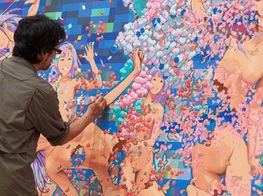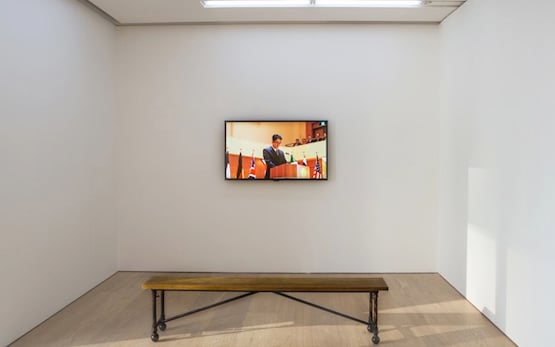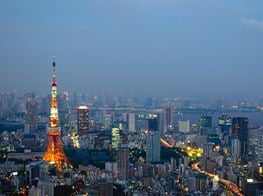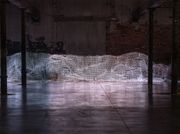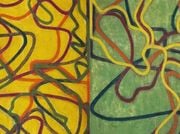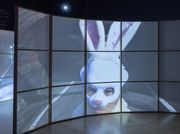Makoto Aida
Image: Makoto Aida pictured with his work, The Non-Thinker, 2012. FRP, etc, 313 x 181 x 150 cm. ©Aida Makoto. Courtesy Mizuma Art Gallery.
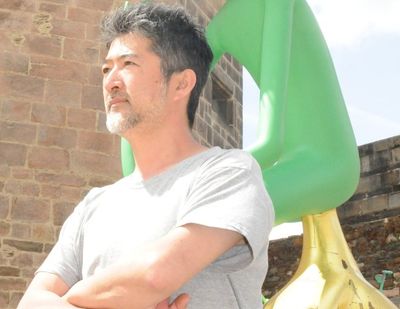
Image: Makoto Aida pictured with his work, The Non-Thinker, 2012. FRP, etc, 313 x 181 x 150 cm. ©Aida Makoto. Courtesy Mizuma Art Gallery.
For more than 20 years, the Tokyo-based contemporary artist Makoto Aida has offered an unflinching social commentary on Japan's modern culture, highlighting the country's complex norms, and exploring topics from sexuality to war.
His works range widely from refined graphic paintings such as A Picture of an Air Raid on New York City (1996), showing Japanese World War II fighter planes attacking the Manhattan skyline, to videos such as Lonely Planet (1998), where the artist sat in front of a world map dialling random numbers to see what languages people use in different countries. One of his most contentious works was the 'Assisted Suicide Machine' series (1986–2002), comprising nooses made of hiking and safety equipment designed to collapse under the weight of the victim. A small plastic stool to help a child reach a noose formed the most notorious object in the series.
In an exhibition at Galerie Perrotin in Hong Kong, (26 November 2014–10 January 2015), Aida presented two new works: Comet-chan—a sculpture of an adolescent alien girl holding a copy of the Gutenberg Bible in her left hand while about to wipe fluorescent pink faeces from her rear—and a video work where the artist appears as the Japanese prime minister pleading in stilted English for other countries to follow the system of 'Sakoku' or closing off of the foreign trade and diplomatic relations that Japan followed during the Edo period. This Ocula Conversation is a combination of two seperate interviews, which both took place in Hong Kong on the occasion of the opening of the Galerie Perrotin exhibition.
Aida says he kept in mind that the works he would show at Galerie Perrotin would be presented alongside a concurrent exhibition at the gallery by Sophie Calle. 'Generally speaking, I don't think these works go well with Calle. However, instead of showing something similar, I thought it would be more interesting to show something opposite or contrasting in effect. In her works, Calle focuses on the lives of existing individuals. My understanding is that she seeks to think of human beings in a universal way. For my own part, however, in both my everyday life and artwork, I try to stay far away from the individual perspective. I have a habit of placing human beings in a thought experiment that represents an extreme situation. To me, these are the two polarities when it comes to examining the human condition. And so I wanted to confront the audience with these two extremes on one floor.'
CSYou work in a wide variety of artistic mediums and scales. Which do feel most comfortable with?
MAI am most used to painting because I originally studied oil painting though I don't think I had a particularly unique touch, especially when I was young. Now I think that it is more about taking a concept and knowing that I can use video or installation or writing to express it. Actually I see myself more as a writer.
On the subject of scale, in Japan, contemporary art museums have huge spaces with high ceilings so we have many opportunities to create large works. Artists are always tempted to create something monumental—it is like wanting to build a pyramid. I am attracted to the gap between that and individual smaller works.
I have worked with some very big works like my painting of salarymen (Ash Color Mountains, 2009–2011), which was big. Now that I am middle-aged, I think this is the time when I can go out and do big things even if they might be bad. It is not about bravery but more about energy. Originally I thought you should never work on anything bigger than yourself, but now is the time to challenge myself, so I want to spend more time on these large-scale works. Later on when I am not so strong or powerful I will come back to my own scale.
ADAccompanying your 2012 retrospective at Tokyo's Mori Art Museum was a manifesto, titled 'How to Become the World's Greatest Artist'. In it, you said 'Never repeat the same—or even similar—thing twice.' While the manifesto was not intended to be serious, the range of your work in fact suggests this is a self-imposed rule you possibly are governed by?
MAOriginally the manifesto was meant to be a joke. If you follow that advice, you probably will fail as an artist; artists tend to succeed if they continually do 'about' the same thing.
I have ADHD, and am very active. I cannot keep on doing the same thing. I have to keep on doing different things.
ADYour paintings are often incredibly labour-intensive, and I understand that you complete all of the work yourself and this is important to you. If correct, then why, as someone who is defined very much as a conceptual artist, is this labour so important to you?
MAHa! I used to complete it all myself, but now I have help. But I want to talk about the term of 'conceptual' artist. I have something to say about this term. For me, the term 'conceptual artist' is not a very positive term; it sounds like the artist is very smart, has good ideas, but once they provide the idea, their role is over. I don't believe a typical 'conceptual artist' has the feeling of needing to serve the audience or to do anything beyond the idea. But for me, the audience is very important. I want to share with the audience, so that is why I don't just offer ideas and concepts, but I try to paint and show the work. So that is the difference between a typical 'conceptual artist' and myself.
ADCan you please expand further on the relationship between your work and its audience?
MAFor me, it is very important that there is an audience to see the work. I am not making art for 'art's sake', or for my own satisfaction. I am creating it for an audience. I always have an audience in mind when I am creating work, and what I would like to show them.
ADWhen you discuss having the 'audience in mind', are you referring to a generic audience, or are the works made with a specific audience in mind?
MAI bought two pieces of work to Hong Kong, and for two reasons. First, I wanted to show them specifically to a Hong Kong audience. Second, I was thinking of the audience's experience of this exhibition having regard to the fact that Sophie Calle would be showing also. I didn't decide on my works until I knew what Sophie would be showing.
Of these two pieces of work, the video work is especially relevant to the Hong Kong audience. Hong Kong is like Japan, insofar as it is part of Asia, but it is also very unlike Japan, in that it is very international and used to be a British colony, and English is the official language here—so this work is perhaps different from what I would show to a Japanese audience.
ADBut the work features you playing the Japanese prime minister, so it is very related to Japan?
MAJapanese people, including the prime minister, are not very good at speaking in English. I believe one of the reasons there are so few people in Japan who can speak good English is because Japan has never been a colony. It has never been a European country, and it is interesting because usually if a country hasn't being colonised, it is a blessing. However, if you have never become a colony, it also means you are not very international. So actually, what is better: becoming a colony or not becoming a colony?
CSDoes your work suffer from being 'lost in translation' outside of Japan?
MAWell, my video work on show at Galerie Perrotin is all about Japan being left behind—all alone—in the world. One of the main barriers between Japan and the rest of the world is language. There is also a gap between what people think is domestic Japanese art and international art. I always keep that in mind when I am creating a new work.
CSIs that because Japanese artists, particularly within the manga tradition where females are often depicted in a highly sexualised manner, are more comfortable staying within Japan than trying to explain themselves on the international stage?
MAThat is very true. When you are comfortable with your own world and people of your own nationality you become self-satisfied with your environment and too comfortable with the feeling of being comfortable. It also means artists become too inward-looking and don't consider what is outside of their comfortable world.
It is probably more likely to be Japanese audiences who find my work most understandable compared to foreigners. It is difficult for them to understand the complex nature of kawaii culture.
Look at Comet-chan, I'd like people coming to the gallery to think of it as a kind of joke—to laugh when they see it. The Gutenberg Bible is considered very important, but it didn't have to be a bible for this artwork, it could have been a famous painting like the Mona Lisa by someone like da Vinci. I wanted to show that humans often attach meaning to things that they think are super-important but what would an extra-terrestrial think if they looked at these 'important' things from outer space? It is the gap between what humans and aliens think. Of course, I knew this would also be seen in this joint exhibition with Sophie's work, so it is a little bit like water and oil, another gap or contrast. It is always about the space in-between.
ADComet-chan has a sort of appearance as a monumental statue.
MAI suppose Comet-chan does have the look of a monument. 'Monument for Nothing' is a title I have used for both works and also for exhibitions. I am interested in this idea of 'monument'. When you look at famous political figures that lose power, so often their loss of power is signified by the toppling or destroying of monuments. For example, Hussein.
Monuments are things that at times have a great deal of value attached to them, but there are also times when their reason for being and the values underpinning them become forgotten. People are similarly revered and then forgotten—Andy Warhol for example: forgotten, and then remembered again. Perhaps there will be a time when people will forget about me, and the things I have made. The value we give to a monument or a piece of art can change over time.
ADYou frequently use humour, or delve into the crude, grotesque and sexually shocking. To what extent do you use this as a tool against a 'passive audience'?
MAI do often try and use the 'shocking' element in my work. But I don't want simple reactions. I don't want my audience just to laugh, or get 'pissed off'. I want to put the audience into a dilemma. They have to think about whether they should laugh or be angry. I like to produce artworks that make it difficult for people to decide on a particular reaction. I don't like simple reactions. I want to arouse complicated emotions, not simple reactions. Human beings are interesting when they are showing complicated reactions. I want to focus more on this.
CSSome people will inevitably see your sculpture of a nubile young girl as misogynistic.
MAI don't even think of this figure as a girl. It is a symbolic existence that usually appears in what we call otaku culture in Japan. I wouldn't have love for this girl, so there is no sexual or personal feeling.
CSWhy does so much of your work reflect themes of disaster and catastrophe?
MAYou see so much disaster in my work because the Japanese mind is always on these issues. Japan is a country where we have always had earthquakes and tsunamis and before I was born it was the nuclear bomb that destroyed a whole city. We have extraordinarily strong images in our mind about destruction and so of course as a Japanese person it is reflected in my work.
CSHow have the 2011 earthquake and tsunami affected your art in particular?
MAWe are quite well prepared as a society for earthquakes but in the case of 2011, people were very shocked by the nuclear plant situation. The impact of that on Japanese society has been very strong. As an artist, of course everyone thinks about if they should use this element in their work or not. In my case I have not used the subject matter yet but that doesn't mean I haven't thought about it a lot.
CSTo what extent do you try to create beauty within your work when the theme is often about chaos?
MABeauty is a word I try to be careful about. I try not to use that word. It is a very difficult concept and from my own personal experience I know that when I tried to make something beautiful I failed so I try not to think about it. If it happens it must be natural. Beauty is not a word the creator should think about or use, beauty should be in the eye of the beholder so if someone thinks it is beautiful, it is.
CSDo you feel negative about the future of Japan?
MAI think Japan probably has a dim future. The population is in decline and we have many other serious problems. In Asia, China used to be the strongest country but after the Opium Wars Japan grew powerful but that was a strange situation as it should always have been China. In the 1990s when the 'Bubble Economy' burst it was only natural for Japan to drop from that artificial peak. There is no reason at all to feel sad about the drop. Japan is returning to its original position in Asia. It is in decline but that doesn't mean you don't get anything of value from it if it can become a more mature society. Unfortunately I am worried this maturity won't happen. —[O]

